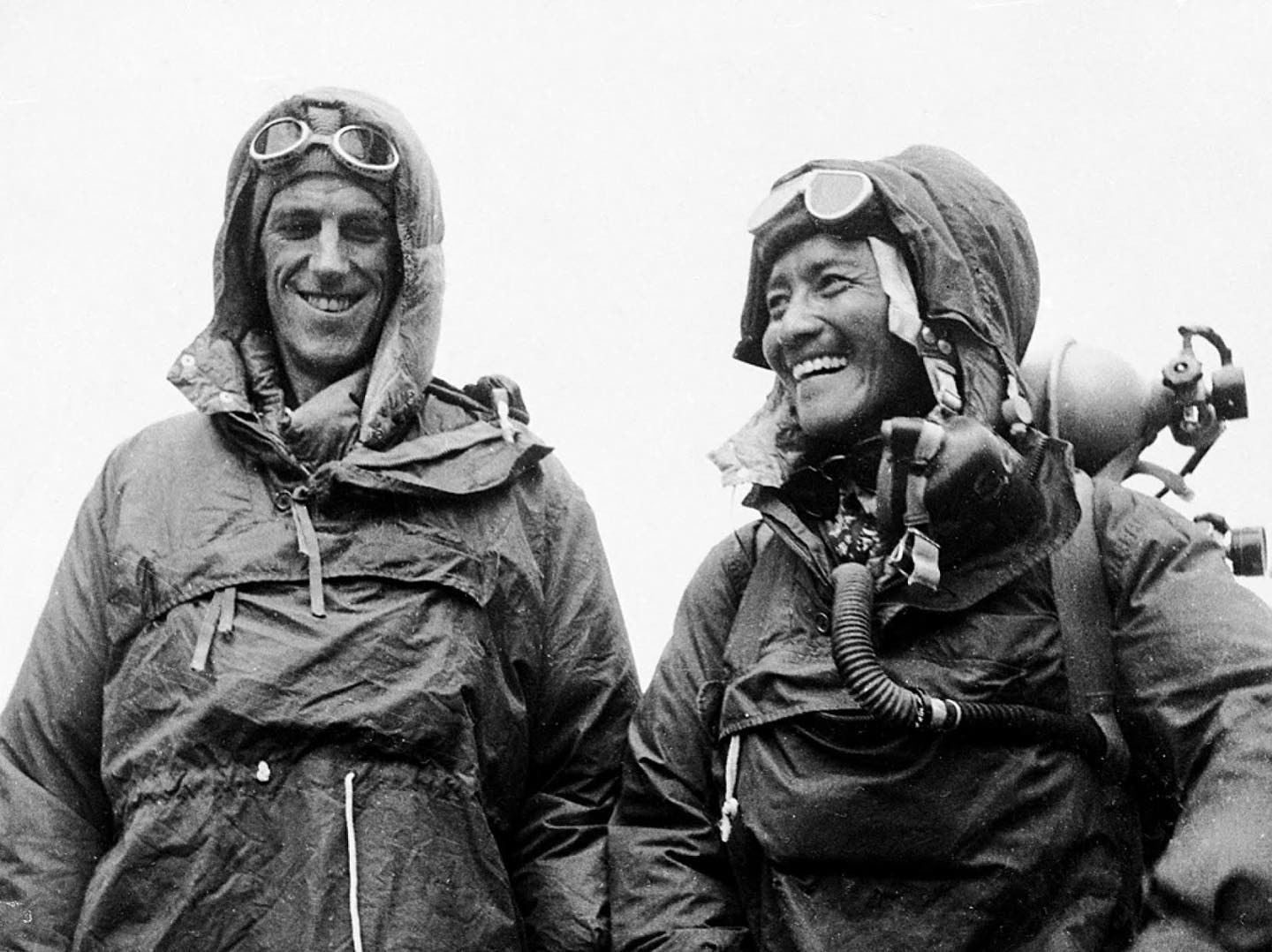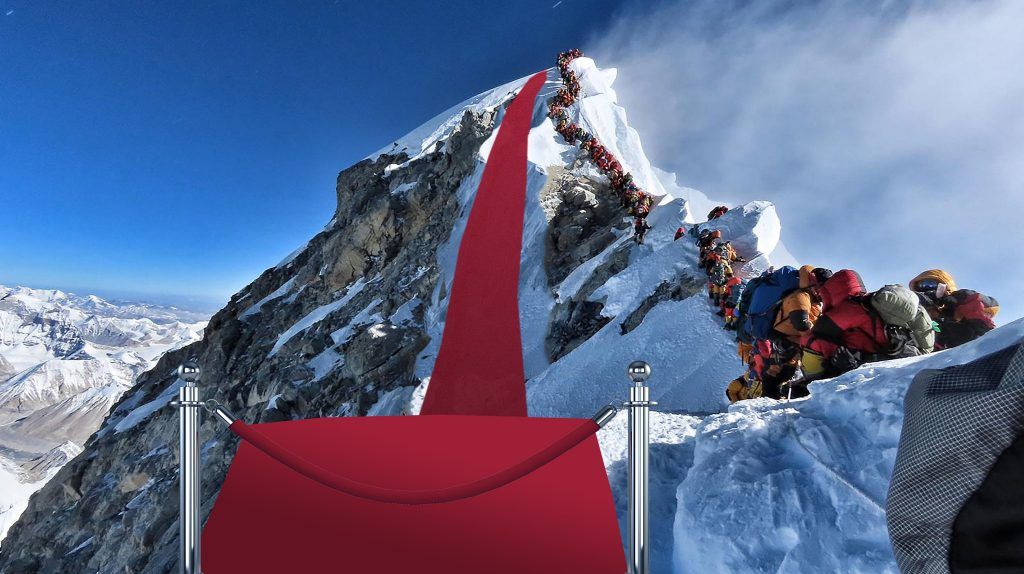On this day in 1953 New Zealand’s Edmund Hillary and Sherpa Tenzing Norgay reached the 29,029 ft. (8848m) foot summit of Everest, becoming the first people to stand atop the world's highest mountain. That day is celebrated in the worldwide community of mountaineers as Sagarmatha Day, Sagarmatha meaning Head in the Great Blue Sky in Nepali. [Everest is also known in Tibetan as ཇོ་མོ་གླང་མ, pronounced Chomolungma and in Chinese as 珠穆朗玛 or Zhumulangma.]
We thought such an auspicious occasion might be a good time to reflect on where Everest mountaineering stands in a coronavirus world and what opportunities still remain for a VIP or VVIP wishing to summit the greatest peak of them all.
The bad news is that for the second time in five years, Everest is completely closed and the crucial ‘spring’ climbing season is beyond salvation.
The closure happened in two stages: on March 11, China banned all climbing expeditions to Everest from the Tibetan side due to coronavirus. Nepal then followed suit a day later. What we’re seeing is similar to 2015 when devastating earthquakes rocked the region – forcing a complete shutdown.
In fact the only people who are likely to climb Everest this year are a 53-person team of Chinese scientists who, it was reported this month, are on the summit at the moment and using China’s network of Beidou satellites to reassess the mountain’s current height and map her natural resources.
The impact on Nepal in particular will be seismic and one can assume that 2021 will see massive demand if travel restrictions have been lifted in time for the ‘spring’ season which runs from late March to early June. So-called adventure tourism is the backbone of Nepal’s tourism economy which generated about US$ 2 billion last year. The shutdown will affect the livelihoods of around a million people well beyond just the Sherpa experts but in the wider communities of shops, restaurants, transportation, hotels, tea houses, B&Bs and other tourism-related businesses.
Whatever the price-point of the specific tour, and there are the equivalent of economy, business, first class and private jet options, just on the climbing side alone the average package is US$ 84,000 including fees the US$ 11,000 royalty fee to the government, expenditures on logistics and local staff and additional items like insurance, extra oxygen etc.
Although 2019 [and 2018] were record years for the numbers who summited Everest they also represented something of an end of an era: a disastrous ‘traffic jam’ on the mountain contributed to the deaths of 11 climbers.
One of the best-known organisers of Everest expeditions is the Dutch climber Arnold Coster. Here are his offers for Everest [from the south side] starting at US$ 44,500 and Everest from the North side [the original Mallory route] from US$ 47,500
Coster’s website includes a blog, and he was in the miserable position last year of having to update friends and family of two of his clients that they had died. This is how he described the deaths of Marisa and Eric.
On May 20 [2019] our apparently perfect looking summit push turned into disaster. On May 19 the whole team left the South Col and everybody summited the next day, except Marisa who decided to turn around just above the South Summit at 8am in the morning, due to fatigue. All went according to plan, but on the descent two of our members got sick, which resulted in the loss in two of our friends Eric & Marisa. Our team members & staff are totally beaten by our rescue attempts, but arrived back in Base Camp at May 23.
Eric summited Mount Everest on 20 May 8am and fulfilled his childhood dream. During the ascent he was doing well, but after the South Summit he was struggling a bit. Descending from the summit he became slower and slower and it became clear that something was wrong. His Sherpa who was climbing with him from the beginning requested to send an additional Sherpa up with more supplementary Oxygen to help him down. After this we managed to bring him down to the South Col in a reasonable time; he looked beaten, but mentally fine. We brought him to his tent, gave him more Oxygen, lots off drinks and food and it looked like he was recovering. Unexpectedly Eric passed away that evening in his tent accompanied by a Member and Sherpa in his tent.
Marisa was doing well until the ‘Balcony’, but became very slow after this and decided to turn around on the South Summit at 8am in the morning. Normally this would give her enough time to descent safely, but her condition deteriorated rapidly. Halfway between the South Summit and Balcony she was hardly able to move and became very confused. Her Husband and several Sherpa’s struggled all night to bring her down and miraculously she made it back to the South Col 2am that night, after spending 31 hours above the camp. We managed to stabilize her that night with Medicine & Oxygen and Marisa was able to walk out of the tent herself the next morning. Helicopter rescue is only possible from Camp 3, so we continued our descent the next morning. Marisa was able to walk herself, but 2 hours out of camp she collapsed on the ‘Geneva Spur’. Her Husband tried to retrieve her, but this was not possible anymore. Rob was evacuated by helicopter from Camp 2 the next day and is in Kathmandu now.
We share these painful insights not to be ghoulish but as a genuine reminder that climbing Everest is a dangerous business. Everest has the highest numbers of absolute deaths of any mountain about 8000m with especially bad years in 2014 [17 deaths], 2015 [14] and 2019 [11].
But better gear, weather forecasting and the support offered by commercial operations like Coster’s means the percentage of those who die have dropped considerably: between 1923 and 1999 the fatality rate was 14.5 percent of those who tried to summit; from 2000 to the end of last year it was 1.5 percent. [Annapurna by contrast takes the lives of a third of those who try, the highest rate amongst the ‘eight-thousanders’.]
DAIMANI has no formal relationship with any company offering tours to the top of Mount Everest so do not consider this list as either exhaustive or an endorsement; agencies that trusted third parties DAIMANI uses have mentioned, include:
- New Zealand-HQd Adventure Consultants, who also offer European mountaineering options as well as North and South Pole excursions. They are taking bookings for the 2021 season, with prices starting from US$ 69,000 and a US$ 15,000 deposit.
- UK-based Jagged Globe, whose ascent costs GB£ 46,775 and a GB£ 1,595 deposit. Their 2021 climbs can be booked below.
- But the most expensive publicly available option – the only one that describes their offer as ‘VVIP’ and a ‘luxurious trip to climb Mount Everest – is that provided by Nepalese-owned Seven Summits Trek. Their chairman is Mingma Sherpa, the first Nepali to summit all of the ‘eight-thousanders’. Their all-inclusive VVIP price is US$130,000.



